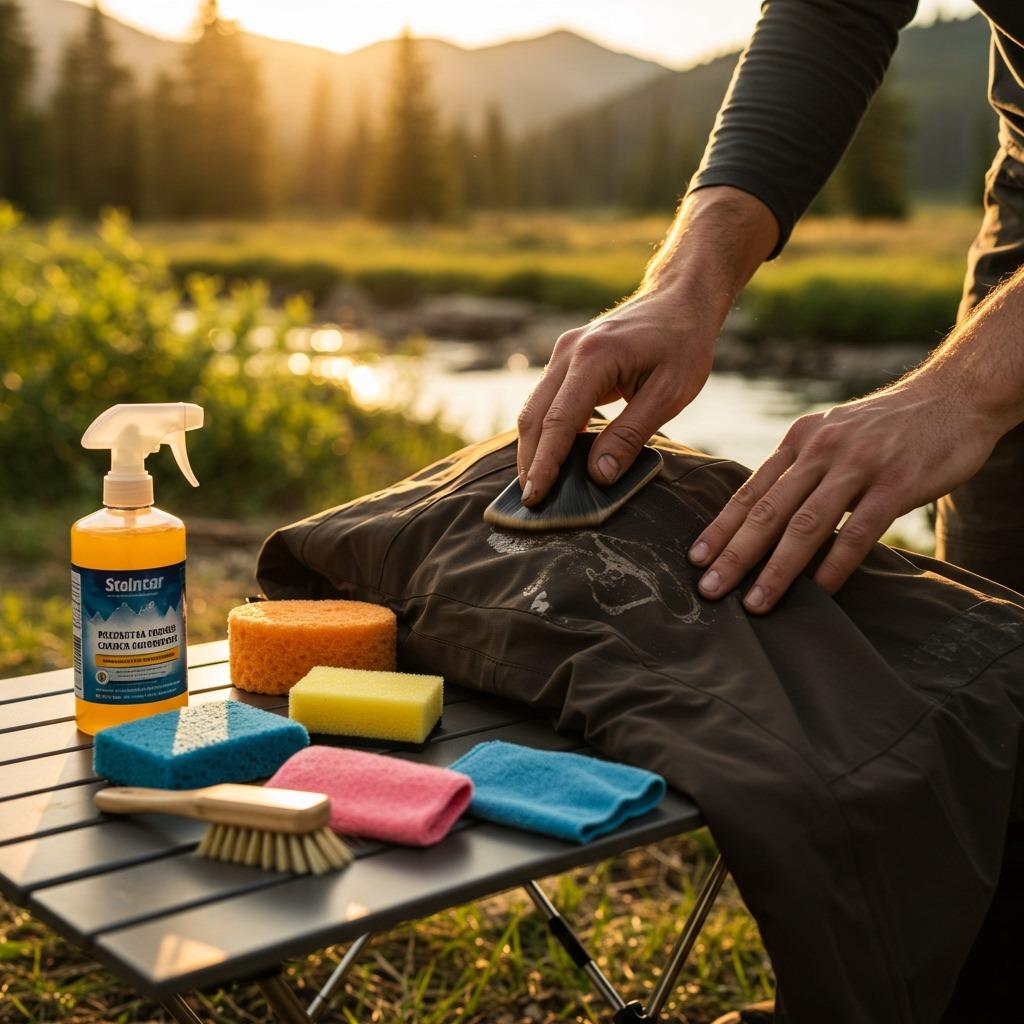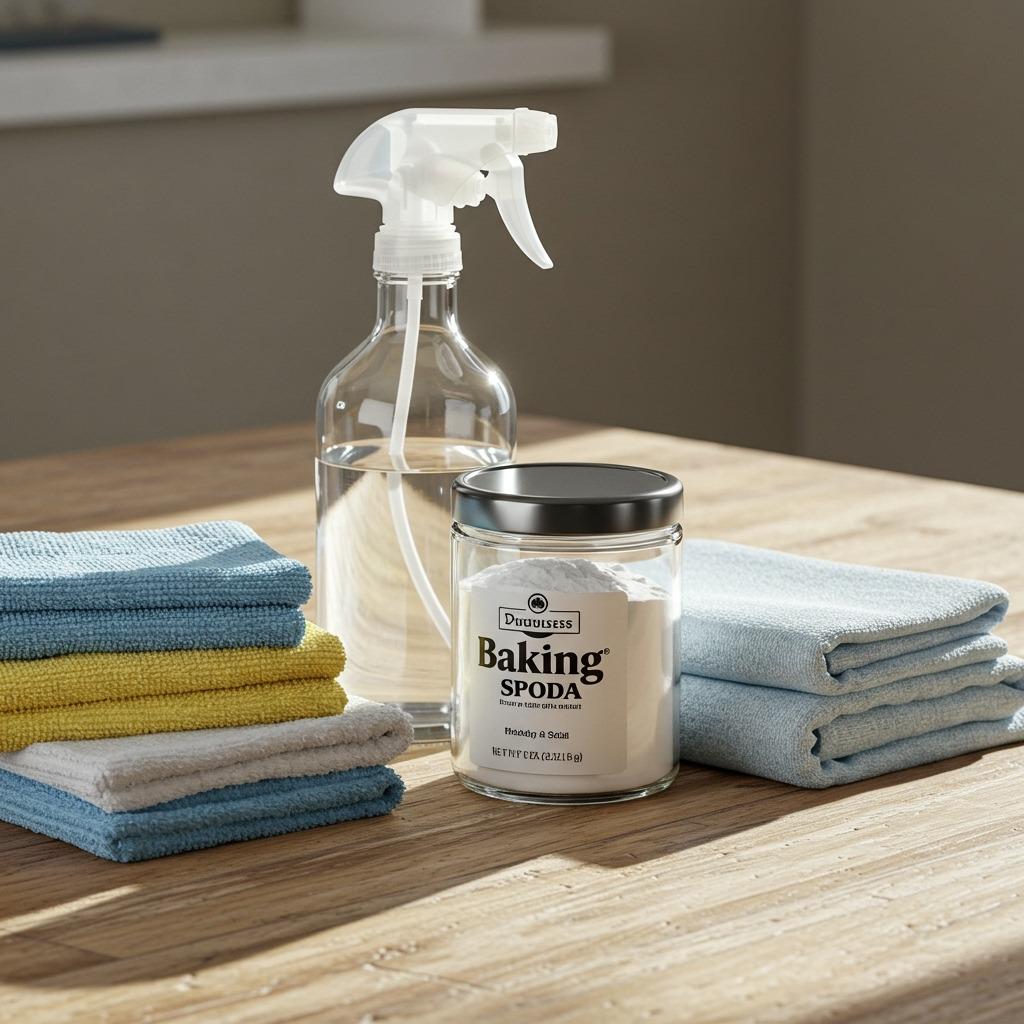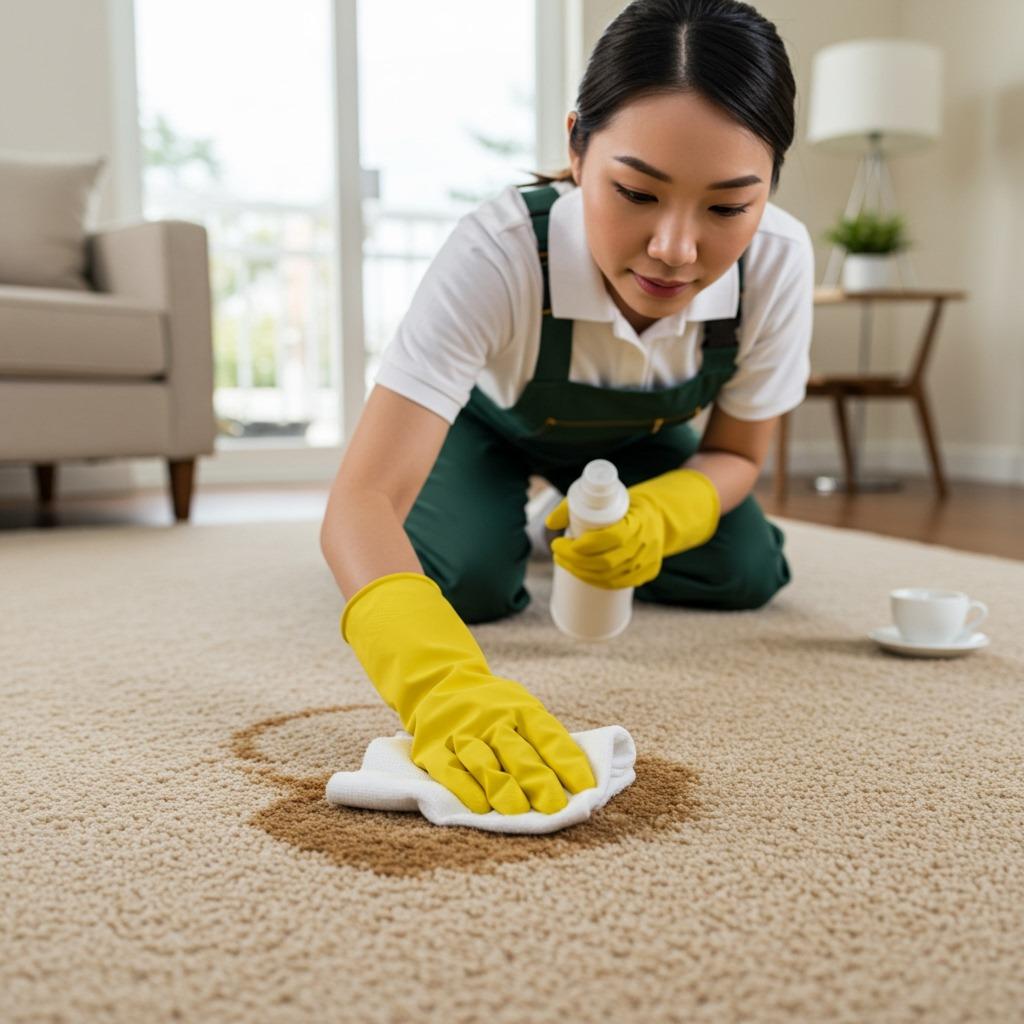I’ll never forget the morning I was rushing to catch a sunrise at the Grand Canyon, thermos of fresh camp coffee in hand, when my hiking boot caught on a tent stake. Coffee went flying everywhere—across my favorite flannel shirt, down my sleeping bag, and straight onto the light-colored tent floor. Standing there in the pre-dawn darkness, watching that brown stain spread like a roadmap of my clumsiness, I thought my gear was ruined forever.
But here’s what I’ve learned through years of outdoor adventures and countless coffee mishaps: coffee stains aren’t the end of the world, even when they seem impossible to remove. Whether you’re dealing with a fresh spill on your camping gear or discovering an old, set-in stain on your favorite hiking shirt, there are proven methods to get coffee stains out of virtually any material. The key lies in understanding what you’re working with and acting fast—or knowing the right techniques for stubborn, dried stains.
Coffee stains happen to the best of us, especially when we’re juggling our morning brew with outdoor activities, work meetings, or daily routines. The good news is that with the right approach and common household items, most coffee stains can be completely removed without expensive commercial cleaners or professional services.
Understanding Coffee Stains
Coffee stains are particularly stubborn because they contain tannins—natural plant compounds that bind strongly to fibers and surfaces. These same tannins give coffee its rich color and bold flavor, but they’re also responsible for creating those persistent brown marks that seem impossible to remove once they set.
The type of coffee matters too. Black coffee creates different stains than coffee with cream or sugar. Cream adds protein and fat to the mix, while sugar can caramelize when heated, making removal more challenging. Understanding these differences helps determine the best removal approach for your specific situation.
Fresh stains are always easier to remove than set-in ones because the tannins haven’t had time to fully bond with the material. This is why immediate action makes such a difference in successful stain removal.

Essential Supplies for Coffee Stain Removal
Before diving into specific removal methods, gather these common household items that work effectively against coffee stains:
Basic supplies:
- Clean white cloths or paper towels
- Cold water
- White vinegar
- Liquid dish soap (not laundry detergent)
- Baking soda
- Rubbing alcohol
For tougher stains:
- Enzyme cleaner
- Hydrogen peroxide
- Commercial stain remover
Equipment:
- Spray bottle
- Soft brush or old toothbrush
- Vacuum cleaner (for carpet stains)
Having these items readily available means you can tackle stains immediately, significantly improving your chances of complete removal.
Removing Coffee Stains from Clothing
Fresh Coffee Stains on Fabric
When coffee hits your clothing, speed is your best friend. The Food52 cleaning experts recommend this immediate action plan:
Step 1: Blot immediately
Use a clean, dry cloth to blot up as much coffee as possible. Work from the outside of the stain toward the center to prevent spreading. Never rub or scrub, as this pushes coffee deeper into the fibers.
Step 2: Flush with cold water
Hold the stained area under cold running water, letting the water run through the back of the fabric. This helps push the coffee out of the fibers rather than deeper in. Continue for 3-5 minutes or until the water runs clear.
Step 3: Apply dish soap
Work a small amount of liquid dish soap directly into the stain with your fingers. Let it sit for 5-10 minutes to break down the oils and tannins.
Step 4: Rinse and assess
Rinse thoroughly with cold water. If the stain persists, move to more intensive methods before the fabric dries.
Synthetic Fabrics (Polyester, Nylon, Spandex)
Synthetic fabrics are generally more forgiving when it comes to stain removal. According to DriftAway Coffee, the process for synthetic materials follows this pattern:
Pre-soak solution:
- 1 quart warm water
- ½ teaspoon liquid dish soap
- 1 tablespoon white vinegar
Mix these ingredients and soak the stained area for 15 minutes. The vinegar helps break down tannins while dish soap tackles any oils or creamer residue.
Final treatment:
After soaking, rinse with warm water, then use a sponge dipped in rubbing alcohol to blot any remaining stain. Work from the outside of the stain inward, then wash as normal.
Cotton and Linen
Natural fibers require slightly different handling due to their absorbent nature:
Method 1: Commercial stain remover
Apply a commercial stain remover according to package directions and wash immediately in the hottest water safe for the fabric.
Method 2: Homemade solution
If you don’t have commercial stain remover, use the same vinegar-soap solution recommended for synthetics, but add an extra rinse step with warm water before air-drying.
Method 3: Hot water flush (for stubborn stains)
For cotton only, stretch the stained fabric over a bowl using a rubber band. Pour near-boiling water (200°F) over the stain from a height of 12 inches. This method flushes out deep-set tannins but should only be used on pure cotton that can handle high heat.

Coffee Stains on Carpets and Upholstery
Carpet and furniture stains require different approaches since you can’t simply toss them in the washing machine.
Fresh Carpet Stains
Immediate response:
- Blot up liquid immediately using clean, dry towels
- Work from outside edges toward the center.
- Apply cold water sparingly to dilute the remaining stain.
- Blot again with dry towels
- Use a fan to speed drying and prevent mold.
Set-in Carpet Stains
For older, dried coffee stains on carpet:
Cleaning solution:
- 1 tablespoon white vinegar
- 1 tablespoon liquid dish soap
- 2 cups warm water
Application process:
- Apply the solution to the stain using a spray bottle or a clean cloth
- Let’s sit for 5-10 minutes.
- Blot with a clean cloth, working outward from the center
- Rinse the area with clean water using a spray bottle.
- Blot dry with clean towels
- Use a fan to thoroughly dry the area.
For heavily soiled carpet, the Cleaning Institute recommends following up with an enzyme cleaner, which breaks down protein-based stains more effectively than traditional cleaners.
Upholstery Stains
Upholstered furniture requires gentle handling to avoid water damage or fabric shrinkage:
Vinegar solution method:
- Equal parts cold water and white vinegar
- Test in an inconspicuous area first.
- Apply with a clean cloth, working from the outside in.
- Blot with a dry cloth to remove moisture
- Allow to air dry completely.
Baking soda paste method:
For stubborn upholstery stains, create a paste with baking soda and water. Apply to stain, let dry completely, then vacuum away. This method works particularly well for odor removal along with stain elimination.
Wood Furniture Coffee Stains
Wood surfaces present unique challenges because traditional water-based solutions can damage finishes or create water rings.
Light Wood Stains
Immediate treatment:
- Blot up coffee immediately with a dry cloth
- Apply white vinegar directly to the stain using a cotton swab.
- Let’s sit for 2-3 minutes.
- Wipe clean with a damp cloth.
- Dry immediately and apply wood polish if needed.
Baking soda method:
For persistent stains, create a paste with baking soda and water. Apply to stain, let sit 10-15 minutes, then wipe away with a slightly damp cloth. This method is gentler on wood finishes than harsh chemicals.
Deep Wood Stains
When coffee has penetrated the wood finish, more intensive treatment may be necessary:
Toothpaste method:
Non-gel toothpaste contains mild abrasives that can help lift stains from wood. Apply a small amount to cotton cloth and gently rub in a circular motion. Wipe clean and apply wood conditioner.
Lemon and olive oil:
Mix equal parts lemon juice and olive oil. Apply to stain with a soft cloth, let sit 15 minutes, then buff clean. This method both removes stains and conditions the wood.
Advanced Stain Removal Techniques
Enzyme Cleaners for Protein-Based Stains
Coffee with cream or milk contains proteins that regular detergents can’t fully break down. Enzyme cleaners contain biological agents that specifically target protein molecules:
Application:
- Apply the enzyme cleaner directly to the stain
- Let sit 15-30 minutes (follow product instructions)
- Rinse thoroughly with cold water.
- Wash or clean as normal.
Hydrogen Peroxide for White Fabrics
For white or light-colored items that can handle bleaching:
Safety first: Always test in an inconspicuous area
Application: Mix equal parts hydrogen peroxide and water, apply to the stain, let sit 10 minutes, then rinse thoroughly
Club Soda Method
Club soda can be surprisingly effective for fresh coffee stains due to its carbonation and mineral content:
- Pour club soda directly onto the fresh stain
- Let bubbles work for 2-3 minutes.
- Blot with a clean cloth
- Repeat as needed
- Follow with the normal cleaning process.

Prevention and Quick Response Tips
Creating a Coffee Spill Kit
For frequent coffee drinkers and outdoor enthusiasts, prepare a portable stain removal kit:
Car/office kit:
- Travel-size stain remover pen
- Small pack of wet wipes
- Mini spray bottle with vinegar solution
- Clean white cloths
Camping kit:
- Biodegradable soap
- Small container of baking soda
- Multi-use vinegar
- Quick-dry towels
Protective Measures
For clothing:
- Choose darker colors for coffee-drinking days
- Apply fabric protector to frequently worn items.
- Keep a spare shirt at work or in your car.
For furniture:
- Use coasters and placemats consistently
- Apply fabric protection spray to upholstered furniture.
- Consider washable slipcovers for high-risk areas.
Quick Response Protocol
When spills happen away from home:
- Don’t panic – most stains can be removed later
- Blot immediately with any available absorbent material
- Dilute with cold water if available.
- Mark the spot so you can find it later for proper treatment.
- Treat as soon as possible once you have proper supplies.
Common Mistakes to Avoid
Heat Application
Never use hot water on fresh coffee stains—heat sets tannins permanently into fibers. This includes hot water rinsing, hair dryers, or putting stained items in hot dryers before stains are completely removed.
Rubbing or Scrubbing
Aggressive scrubbing spreads stains and can damage fabric fibers. Always blot gently and work from outside edges toward the center.
Wrong Cleaning Products
- Don’t use laundry detergent for pre-treatment (it’s formulated for washing machines)
- Avoid bleach on colored fabrics.
- Don’t mix different cleaning chemicals.
Ignoring Fabric Care Labels
Some fabrics require professional cleaning. When in doubt, take valuable items to professional cleaners rather than risk damage with DIY methods.
When to Call Professionals
Certain situations warrant professional cleaning services:
Valuable or delicate items:
- Silk, wool, or cashmere garments
- Antique furniture or heirloom pieces
- Designer clothing or expensive gear
Large or persistent stains:
- Wall-to-wall carpet stains
- Multiple stains or large spill areas
- Stains that have been heat-set or repeatedly treated unsuccessfully
Health concerns:
- Moldy or mildewed areas
- Stains combined with other substances
- When allergies or sensitivities are a concern
Professional cleaners have access to industrial-grade equipment and specialized cleaning solutions that aren’t available for home use.
Maintaining Your Cleaning Success
After successfully removing coffee stains, take steps to prevent future problems:
Regular maintenance:
- Vacuum carpets weekly to prevent dirt buildup that makes stains harder to remove
- Clean spills immediately before they set
- Rotate frequently used items to distribute wear.
Seasonal deep cleaning:
Schedule professional cleaning for carpets and upholstery annually, especially in high-traffic areas where spills are more likely.
Documentation:
Keep a record of what cleaning methods work best for your specific fabrics and surfaces. This saves time during future stain removal efforts.
Coffee stains don’t have to be permanent fixtures in your life. Whether you’re dealing with a fresh spill on your camping clothes or discovering an old stain on your favorite hiking gear, the right approach can restore your items to their original condition. The key is understanding your materials, acting quickly when possible, and having patience with the cleaning process.
Remember that successful stain removal often requires multiple attempts, especially with older or set-in stains. Don’t give up after the first try—persistence and the right techniques will eventually win out against even the most stubborn coffee stains.
With these proven methods in your toolkit, you can enjoy your morning coffee ritual whether you’re at home or in the great outdoors, knowing that accidental spills don’t have to ruin your day—or your gear.
Frequently Asked Questions
What’s the most effective way to remove fresh coffee stains?
The most effective approach for fresh coffee stains is immediate action: blot (don’t rub) to absorb liquid, flush with cold water from the back of the fabric, apply liquid dish soap, let sit 5-10 minutes, then rinse thoroughly. Acting within the first few minutes dramatically improves removal success.
Can old, set-in coffee stains be removed completely?
Yes, old coffee stains can often be removed completely, though they require more intensive treatment. Use enzyme cleaners for protein-based stains, create soaking solutions with vinegar and dish soap, and be prepared to repeat the process multiple times. Heat-set stains are the most challenging but not impossible to remove.
Is it safe to use bleach on coffee stains?
Only use bleach on white, bleach-safe fabrics, and never mix bleach with other cleaning chemicals. For colored fabrics, use hydrogen peroxide diluted with water instead. Always test any bleaching agent in an inconspicuous area first.
What household items work best for coffee stain removal?
The most effective household items are white vinegar, liquid dish soap, baking soda, and rubbing alcohol. White vinegar breaks down tannins, dish soap tackles oils, baking soda absorbs odors and stains, and rubbing alcohol helps lift remaining residue.
Should I use hot or cold water for coffee stains?
Always use cold water initially for coffee stain removal. Hot water sets tannins permanently into fibers, making stains nearly impossible to remove. Only use hot water for final rinsing on cotton fabrics after the stain has been completely treated and removed.

